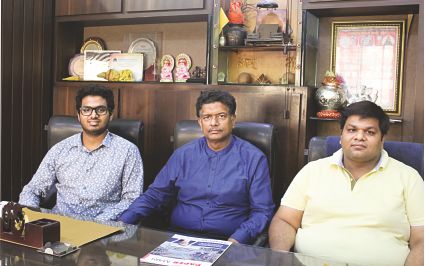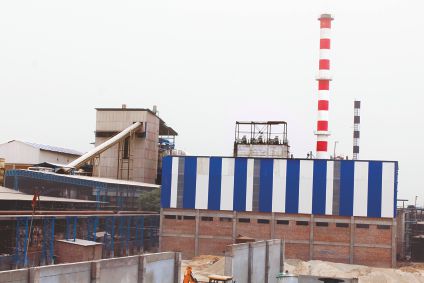The company’s new plant is built around the increasing demand of the coated paper in the market and visible undersupply by the domestic production. The company is planning to produce writing & printing, cupstock, and other value-added varieties in the new plant. Targeting to offset the increasing imports in coated paper to some extent, Silverton would be the third player in the variety with a significant capacity after BILT and JK Paper.

Silverton Pulp & Papers Private Limited is already producing around 82,000 TPA of quality kraft paper in its existing mill, and with the new plant its total capacity would reach a considerable figure in Muzaffarnagar cluster. Paper Mart recently visited the mill’s site to witness the swift progress of work at the new plant, which is almost near completion and is commissioning stage. The existing kraft mill shares the same location in the vicinity.
Here are the excerpts of the interaction with Mr. Akshay Jain, MD, Silverton Pulp & Papers Private Limited, who sounded buoyant about the prospects of the new plant.
Paper Mart: Take us through the journey so far of Silverton Papers.
Akshay Jain: We forayed in the paper industry in 1990 with Garg Duplex & Paper Mill Pvt. Ltd. with a capacity of just 15 TPD. In 2004, Silverton Pulp & Papers Pvt. Ltd. was incorporated with a small 50 TPD writing and printing unit to produce low-quality recycled-based paper. Later, in the year 2011, we changed this mill to a triple-wire packaging paper machine and started making 200 TPD of kraft paper in the BF range 18-35, one of the best qualities in North India and well appreciated by the customers.
We are now at an interesting point in this journey. Silverton is setting up a 100,000 TPA coated paper plant as a Greenfield project and is almost done with the construction and machine erection works. The total investment is over Rs. 200 Cr (INR 2,000 Mn) and the plant would be commissioned positively by the end of July this year. There is also a captive power plant for in the new unit. The coated paper varieties coming from the unit would be mainly writing and printing, cupstock, and other value added products. The plant is located at the existing site in Muzaffarnagar. Our cumulative capacity after this plant becomes operational would be around 182,000 TPA.
PM: What factors did motivate you to take up a Greenfield project in coated paper?
AJ: The most visible of factors is the steadily increasing demand of coated paper in our country as is evident by the increasing imports in the segment. Secondly, we saw no other project coming up in the coated paper segment and this was a good opportunity for us to do so. Moreover, we were eagerly looking for all possibilities of diversification of our product range and were considering duplex board and coated paper as options, eventually making up our mind on coated paper. In duplex board, we saw some big expansions and Greenfield projects already underway, which we feared might lead to overcapacity and price crash.
BILT and JK Paper are the main coated paper players in India, sharing almost whole of the domestic production between them. However, their combined capacity still falls short of the total market demand, of which 60 percent is met through imports. Keeping in mind these factors along with logistics, product, and the value-addition, we have put in this project. Fortunately, we have got the machine from Italy which was already manufacturing the best quality paper there. That is going to be our major strength and we are expecting a good paper out of it.
PM: As you said that you have got an absolutely first rate paper machine from Italy, kindly elaborate on the major technologies installed and adopted in the upcoming mill!
AJ: The technologies we have considered for the new plant are among the best globally. The machine, which is procured for the mill, has been imported from Europe. Even though the machine is a secondhand machine, most of its part has been replaced by new ones, imported from Europe itself. For unhindered power generations, we have put heavy-duty industrial gas turbines from Siemens.
Further, for the wet-end part, the approach-flow system is from Voith. The highly unique and power saving vacuum system has been bought from Runtech. In India, we are the first one to order this vacuum blower, which I would say is a revolutionary technology for the paper industry. Besides, the machine has headbox and formers from Voith. The machine also has a tri-nip press, 53 dryers, film press, two super calendars, one globe rewinder, etc. Moreover, we have installed one Pasaban sheeter and one Wrapmatic ream wrapping line for packing of the paper in the converting section of the mill. The entire papermaking system would be DCS controlled, which would give us better control on processes inside the mill.
PM: Can you elaborate more on the products coming from the upcoming mills along with their applications and markets?
AJ: In simple terms, coated paper is nothing but white paper having a clay coating on it with super finished quality. To improve the appearance and printing surface of printing papers, coatings, often made of clay and other additives, are added. Often a mixture of materials or a polymer is used as additive, such as clay, talc, or calcium carbonate. We have an on-site PCC (Precipitated Calcium Carbonate) plant built by Gulshan Polyols under lease agreement.
The large scale use of coated paper is usually in packaging industry and magazines, which are going to be two major customer categories for us. We are thinking of supplying our paper (C1S/C2S) with 90 brightness to publishers and copy manufacturers. However, there are various other applications such as high quality posters, advertising pieces, leaflets, brochures, calendars, etc where our products will be sought. We will also produce cupstock grade for cup manufacturers and gutka paper for pouch manufacturers. These are some of the product grades and respective markets for us. We will first stabilize our machine on writing and printing paper and then start the coated paper production. Since it is a zero tolerance grade, it will take two months to stabilize it.

We are targeting complete North India as a market. The North Indian market is a big one for us and above all, there is no new production in writing and printing grades coming up in the region anytime soon. In fact, most of the mills producing writing and printing have now shifted to newsprint because the import prices have gone up drastically in the last 6-7 months. This vacuum is good for us to market our products as soon as we start making it. The current market has immense demand for quality writing and printing paper.
PM: In the existing plant, what all grades are you producing?
AJ: We are making 18-35 BF kraft paper (uncoated variety) – a grade used for making boxes. We are also making some Korean kraft used for specialized packaging and fancy items. Now, when the new mill with the coating section would be ready, we would be able to make coated paper, which only two mills – JK and Ballarpur in North India – are making as of now. We are the third one coming up with the coating section in the new mill.
PM: What is the make-up of raw material in the current as well as the upcoming mill?
AJ: In the existing kraft paper mill, we are importing 80 percent of the raw material. We have developed a stock preparation method that turns weaker wastepaper grades turn into high-end feed for our paper machines. We have this specialty in the existing mill and we will continue to have it in our new mill as well. Besides, we have got better cleaners and dispensers.
PM: It has been quite some time since the Indian paper industry started raising the issue of growing imports. What’s your take on the issue?
AJ: Despite being a big economy, having a huge population, and people consuming paper in a good amount, there are no new big mills being set up to cater to growing demand, and hence there exists some demand-supply gap creating a scope for imports. However, there is a complex web of factors responsible for the under-capacity in segments where imports are happening. Foremost is the capital intensive nature of the industry together with the cost of capital in India. This factor alone is enough to deter people from setting up bigger projects and thus we find capacities which are small with smaller margins, i.e. Indian mills don’t have the capacity enough to earn margins, which further compounds the problem. This situation overall has led to serious deficit of capacities in some segments, for example, coated paper or even writing & Printing in some cases. Therefore, imports are happening, which again has a dampening effect on the profitability and thus on domestic manufacturing.

If we talk about imports, there seems to be a definite shortage of good quality paper in India as there are not many manufacturers in the country to cater to the demand entirely. The big Asian or European players sell the major portion of their production domestically at a premium, thus earning the desired margins on the cost of total production. They supply or dump the excess quantity, which is also huge from Indian standard, in India at a lower price, which is sometimes even lower than our input cost. This hurts us badly and leads to sacrificing our prices, which in turn impacts the overall profitability. If you don’t earn what you deserve to earn on the total input cost, how will you invest in capacity expansion?
The Indian paper mills in most cases are earning just enough to keep going and imports are making this even worse. The cost of production is steadily going up with labor, raw material, and fuel costs; and with pollution norms becoming stringent resulting in extra compliance cost. I am not saying the imports should not be allowed, but not at the cost of denying us a level playing field, and there must be some safeguard duty. There also must be anti-dumping duty wherever the import is proved to be a case of dumping.
In essence, import is hurting the industry by the price squeeze. It is not that the industry is not able to sell the product, but the industry is not able to determine the prices of their own product. Despite a huge population, India is a buyer’s market and not the seller’s.
PM: What steps should be taken to overcome the challenges you mentioned?
AJ: China has recently banned the imports of low quality wastepaper from various countries and has forced the mills there to buy premium grade wastepaper and pulp. As a result, the prices of quality wastepaper and pulp have shot up suddenly because of large scale buying by big Chinese paper mills. We therefore are left with cheap quality wastepaper and pulp. To rectify this problem, we need to invest extra amount in technology that could efficiently process the cheap quality raw material, and this is an added cost in the cost of production. However, we can make good paper with cheaper grade wastepaper, which is a good thing. This is what China was doing earlier. The current situation is good and favorable to growth of the Indian paper industry.
Further, in North India, I haven’t seen any exports except the value-added goods. But now, even kraft paper, which is a niche grade, is being exported by us to countries like China and UAE. We are exporting to China because China has stopped the over-production so the prices have increased and ours have become at par with the international level. However, we assume that this scenario may not last for more than a year; the reasons are the new production being planned by Chinese paper mills in Vietnam and China relaxing the licensing limitation.
This is a favorable year for the paper industry, and if this kind of scenario persists, the industry will grow and come at a par with the international players.
PM: Do you wish to add something to this conversation?
AK: By the end of August this year, we are targeting to release our paper in the market. We hope to reach the market with products at par with global standard, and with that of JK and BILT, dominating the Indian coated paper scene. Initially, in 2004, Silverton started making writing-printing paper and now we are building the new unit with renewed vigor and vision. With the new unit, profit is not a motto. Silverton desires to earn its name as the producer of quality writing and printing paper and serve the customer with the best quality in the segment.
It’s a huge market for the coated paper in North India as most of the coated paper either come via import or through JK and BILT. The maximum demand is met through the imported paper and Silverton expects to offset the imports to some extent by producing enough quality and quantity. The trend so far looks healthy for us and many good dealers are approaching us with inquiries about the products and commencement of production. We are focusing on value additions and will be focusing on those segments where competition is less for maximum profitability.


